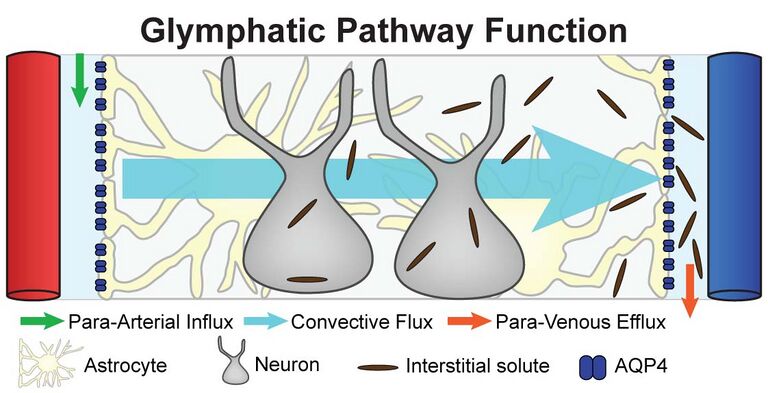Glymphatic System: Difference between revisions
No edit summary |
No edit summary |
||
| (2 intermediate revisions by the same user not shown) | |||
| Line 3: | Line 3: | ||
'''Top Contributors''' - {{Special:Contributors/{{FULLPAGENAME}}}} | '''Top Contributors''' - {{Special:Contributors/{{FULLPAGENAME}}}} | ||
</div> | </div> | ||
== Introduction == | == Introduction == | ||
The glymphatic system is a recently discovered macroscopic waste clearance system that utilizes a unique system of perivascular channels, formed by [[Glial Cells|astroglial cells]], to promote efficient elimination of soluble [[proteins]] and metabolites from the central nervous system. Besides waste elimination, the glymphatic system may also function to help distribute non-waste compounds, such as glucose, lipids, amino acids, and neurotransmitters related to volume transmission, in the [[Brain Anatomy|brain]]. | |||
The glymphatic system function mainly during [[Sleep: Theory, Function and Physiology|sleep]] and is largely disengaged during wakefulness. The biological need for sleep across all species may therefore reflect that the brain must enter a state of activity that enables elimination of potentially neurotoxic waste products, including β-[[Amyloidosis|amyloid]]. | |||
The glymphatic function is suppressed in various diseases this failure of glymphatic function in turn might contribute to pathology in [[Neurodegenerative Disease|neurodegenerative disorders]], [[Traumatic Brain Injury|traumatic brain injury]] and [[stroke]]<ref>Jessen NA, Munk AS, Lundgaard I, Nedergaard M. [https://www.ncbi.nlm.nih.gov/pmc/articles/PMC4636982/ The glymphatic system: a beginner’s guide. Neurochemical research.] 2015 Dec;40(12):2583-99.Available from:https://www.ncbi.nlm.nih.gov/pmc/articles/PMC4636982/<nowiki/>(accessed 21.1.2023)</ref>. | |||
[[File:Glymphatic system schematic.jpg|center|frameless|768x768px]] | |||
== References == | == References == | ||
<references /> | <references /> | ||
[[Category:Neurology]] | |||
[[Category:Head]] | |||
Latest revision as of 07:09, 21 January 2023
Original Editor - Lucinda hampton
Top Contributors - Lucinda hampton
Introduction[edit | edit source]
The glymphatic system is a recently discovered macroscopic waste clearance system that utilizes a unique system of perivascular channels, formed by astroglial cells, to promote efficient elimination of soluble proteins and metabolites from the central nervous system. Besides waste elimination, the glymphatic system may also function to help distribute non-waste compounds, such as glucose, lipids, amino acids, and neurotransmitters related to volume transmission, in the brain.
The glymphatic system function mainly during sleep and is largely disengaged during wakefulness. The biological need for sleep across all species may therefore reflect that the brain must enter a state of activity that enables elimination of potentially neurotoxic waste products, including β-amyloid.
The glymphatic function is suppressed in various diseases this failure of glymphatic function in turn might contribute to pathology in neurodegenerative disorders, traumatic brain injury and stroke[1].
References[edit | edit source]
- ↑ Jessen NA, Munk AS, Lundgaard I, Nedergaard M. The glymphatic system: a beginner’s guide. Neurochemical research. 2015 Dec;40(12):2583-99.Available from:https://www.ncbi.nlm.nih.gov/pmc/articles/PMC4636982/(accessed 21.1.2023)







